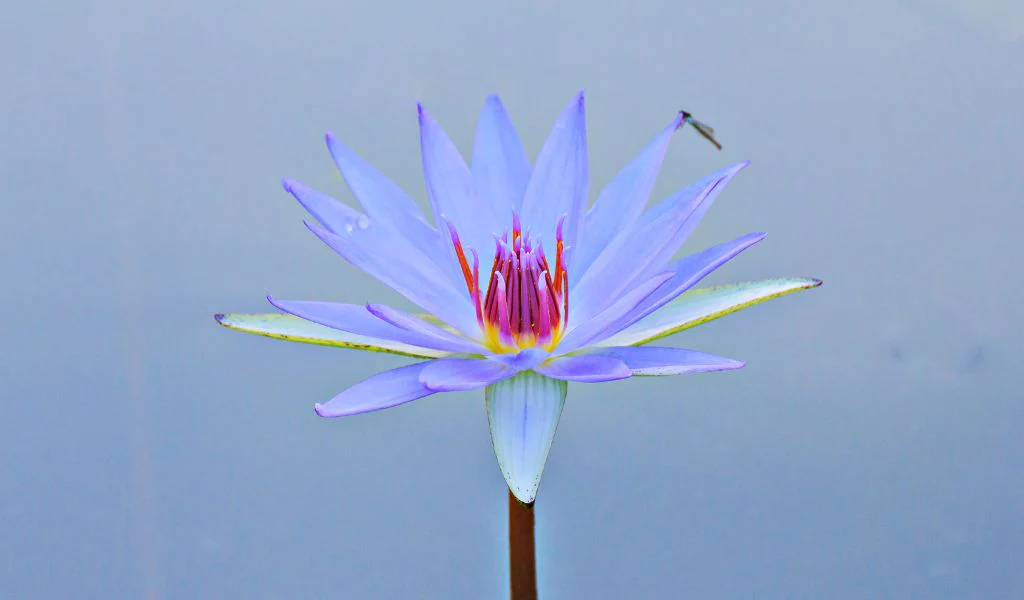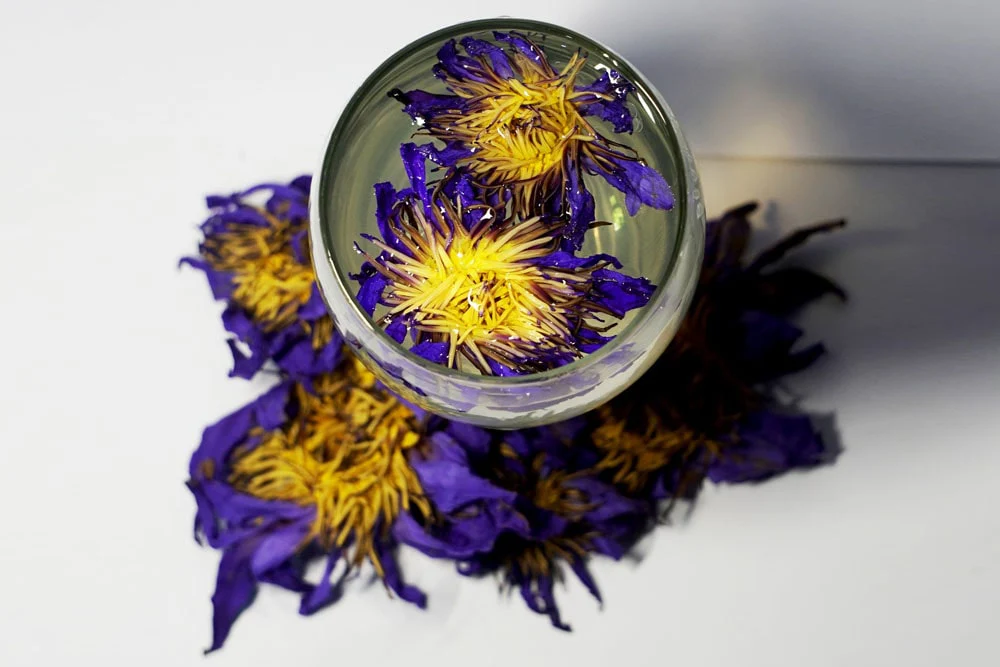Steeped in history and mysticism, blue lotus tea has captivated cultures for millennia. The vibrant blue flower, native to the Nile Valley, was revered by the ancient Egyptians for its purported medicinal and psychoactive properties. Today, this exotic tea continues to pique curiosity, with many seeking to understand the effects of this alluring beverage.

Contents
- A Journey Through Time: The Ancient Allure of Blue Lotus
- Modern Science Unveils the Chemistry Behind the Effects
- Exploring the Potential Benefits of Blue Lotus Tea
- Important Considerations: Safety, Dosage, and Side Effects
- Finding Quality Blue Lotus Tea and Responsible Consumption
- Historical and cultural significance of blue lotus in different societies
- Other applications of blue lotus flower aside from tea
- Conclusion: Unveiling the Potential of Blue Lotus Tea
A Journey Through Time: The Ancient Allure of Blue Lotus
The blue lotus flower, also known as Nymphaea caerulea, has a rich history intertwined with ancient civilizations. Egyptians associated it with the sun god Ra, believing it held the power to induce a state of enlightenment during religious ceremonies. Artistic depictions showcase the flower adorning pharaohs and deities, symbolizing rebirth and spiritual connection.
Beyond Egypt, the blue lotus found reverence in other parts of the world. In India, it was considered sacred in Ayurvedic medicine, believed to possess calming and aphrodisiac qualities.

Modern Science Unveils the Chemistry Behind the Effects
While historical accounts paint a vivid picture of blue lotus’s significance, modern science is starting to shed light on the potential reasons behind its effects. The flower contains various alkaloids, including nuciferine and aporphine, which are thought to be the key players in its influence on the body and mind.
Nuciferine, for example, exhibits properties similar to certain neurotransmitters, potentially influencing mood and sleep patterns. Aporphines, on the other hand, may possess mild sedative and pain-relieving effects. However, it’s important to note that research on blue lotus is still in its early stages, and more studies are needed to fully understand its chemical makeup and precise effects.
Exploring the Potential Benefits of Blue Lotus Tea
Proponents of blue lotus tea tout a range of potential benefits, from relaxation and stress relief to improved sleep and even lucid dreaming. Let’s delve deeper into these claims:
- Relaxation and Stress Relief: The calming properties of certain alkaloids in blue lotus may explain why some users report feeling relaxed and less anxious after consuming the tea.
- Improved Sleep: Nuciferine’s potential influence on sleep neurotransmitters could contribute to better sleep quality for some individuals. However, more research is needed to confirm this effect.
- Lucid Dreaming: A smaller segment of users believe blue lotus tea can enhance the ability to control or become aware during dreams. The reported mechanism behind this is not entirely clear and requires further investigation.
- Aphrodisiac Properties: Historically, blue lotus was associated with increased libido. While the exact reason remains unclear, some believe the flower’s relaxing effects may contribute to heightened sexual experiences. However, substantial scientific evidence to support this claim is lacking.

Important Considerations: Safety, Dosage, and Side Effects
While the potential benefits of blue lotus tea are intriguing, there are crucial factors to consider before trying it. Here’s a breakdown of some key points:
- Safety: Limited research exists on the safety profile of blue lotus tea. Pregnant and breastfeeding women, as well as individuals with certain medical conditions, should consult a healthcare professional before consuming it.
- Dosage: There is no established safe or recommended dosage for blue lotus tea. Effects can vary depending on the individual and the quality of the product. It’s advisable to start with a very low dose and observe the effects before consuming more.
- Side Effects: Potential side effects of blue lotus tea include drowsiness, dizziness, and stomach upset. In rare cases, more severe side effects may occur. It’s crucial to be aware of these possibilities and to discontinue use if any adverse effects arise.
Finding Quality Blue Lotus Tea and Responsible Consumption
If you’re curious about trying blue lotus tea, it’s essential to source it from a reputable vendor that offers high-quality, organic flowers. Avoid products with added ingredients or unknown origins.
Remember, responsible consumption is key. Start with a minimal dose, ideally in the evening due to the potential for drowsiness. Be mindful of potential interactions with medications and avoid using it before operating machinery or driving.

Historical and cultural significance of blue lotus in different societies
The blue lotus flower, with its mesmerizing blue petals, has captivated civilizations for millennia, leaving its mark on history and culture across the globe. Let’s embark on a journey to explore its significance in different societies:
-
Ancient Egypt: Here, the blue lotus reigned supreme. Egyptians associated it with the sun god Ra, believing it held the key to enlightenment during religious ceremonies. Artistic depictions showcase the flower adorning pharaohs and deities, symbolizing rebirth, creation, and the journey towards the afterlife. Offerings of blue lotus flowers were common, and its image graced tombs and temples, signifying its deep connection to the divine.
-
India: Across the vast expanse of Asia, the blue lotus found reverence in Ayurvedic medicine. Considered sacred, it was believed to possess calming and aphrodisiac qualities. It featured in religious ceremonies and artistic representations, often linked to spiritual purity and enlightenment.
-
Other Parts of the World: Evidence suggests the blue lotus’s reach extended beyond these prominent civilizations. Depictions resembling the flower have been found in Mayan artwork, hinting at its potential use in their rituals and symbolism.
The blue lotus transcended mere decoration; it became a powerful symbol woven into the fabric of these societies. It represented rebirth, creation, divine connection, and the pursuit of enlightenment. Even today, the allure of this ancient flower continues to inspire curiosity and exploration.
Other applications of blue lotus flower aside from tea
Beyond the calming cup of blue lotus tea, this captivating flower finds applications in various spheres:
Spiritual and Religious Practices:
The historical significance of blue lotus transcends beverages. In ancient Egypt, it adorned pharaohs and featured in religious ceremonies, symbolizing rebirth and connection to the divine.
Topical Applications:
Some explore the use of blue lotus in salves or oils for its potential calming and pain-relieving properties, though scientific evidence for this remains limited.
Aromatherapy:
The fragrant essence of blue lotus can be enjoyed through aromatherapy diffusers. Proponents believe it may promote relaxation and improve mood.
Art and Decoration:
The vibrant blue flower adds a touch of exotic beauty to floral arrangements, potpourris, and even artistic creations.
It’s important to remember that while these applications exist, more research is required to fully understand the effectiveness and safety of blue lotus in these forms. Consulting a healthcare professional before using blue lotus in any way is always recommended.

Conclusion: Unveiling the Potential of Blue Lotus Tea
Blue lotus tea, steeped in history and shrouded in mystery, continues to capture interest for its purported effects. While scientific research is ongoing, the potential for relaxation, stress relief, and improved sleep is certainly alluring. However, responsible consumption and a cautious approach are paramount. Consulting a healthcare professional before trying blue lotus tea is crucial, especially if you have any underlying health conditions. As science delves deeper into this intriguing flower, the true potential of blue lotus tea may continue to unfold.



